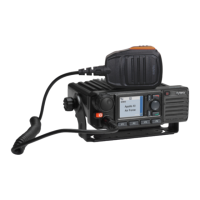–
Step 5 Set the Aeroflex 3920 parameters as follows:
Frq: Be consistent with the TX frequency of the channel to be tested.
STD IB 511: .153
Step 6 Observe the “avg” value of “UUT TX Bit Err” parameter in “UUT Measurements” module of
Aeroflex 3920, which is the average bit error rate of the tested channel during transmitting.
The mobile radio is operating properly when the Aeroflex 3920 parameters are as follows:
FSK Error: ≤5%
Symbol Clock Err: ≤100Hz
Signal Power: 3.9–4.5W
Magnitude Error: ≤1%
UUT TX Bit Err = 0%
Step 7 Click the “Transmit Off” button on Tuner to finish testing.
Receiving
Step 1 Connect the antenna connector of the radio to the RF port of Aeroflex 3920, and set Aeroflex
3920 as follows (remain default values for other parameters):
Frq: Be consistent with the frequency of the channel to be tested.
STD IB 511: .153
Lv1 (signal strength): -116 dBm (-110 dBm by default)
Step 2 Open the Tuner software and go to “TEST -> RX -> Receiver BER (0.153)”.
Step 3 Select the channel to be tested and click the “Start” button on Tuner.
Step 4 Observe the “Average Rate” displayed on Tuner.
You can set different “Average Num” (the calculation base of BER, which is “10” by default) to
obtain different “Average Rate”.
Step 5 Modify the value of “Lv1” parameter of Aeroflex 3920, so as to obtain the average BERs of the
tested channel under different signal strengths.
The mobile radio is operating properly when the average BER is less than 5%.
Note
When the parameter “Lv1” is set to “-110 dBm”, the mobile radio is operating properly when
the average BER is less than 1%.
Step 6 Click the “Stop” button on Tuner to finish testing.

